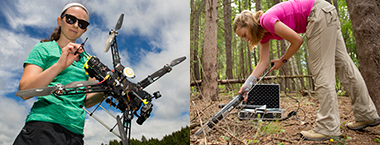Research Grounded Yet Lofty
 |
|
Clare Gaffey, at left, readies an unmanned aerial vehicle — drone — for flight and fellow grad student Marie Orton employs a root scanner to the ground, each to test the effects of carbon dioxide on the growth of a spruce tree in the Huyck Preserve. (Photos by Carlo de Jesus) |
ALBANY, N.Y. (August 31, 2016) — The life cycle of a plant has its ups and downs, just like the rest of us, but UAlbany researchers are investigating it from top to bottom as never before.
At the Huyck Preserve in Rensselaerville, Professor Andrei Lapenas and Assistant Professor Alexander Buyantuev of Geography and Planning, along with two graduate student researchers, are collaborating on studies of spruce phenology — work they believe will help to improve the forecasting of future levels of atmospheric carbon dioxide.
The spruce study is one of several that Lapenas, Buyantuev and several colleagues are collaborating on by using drones. “In Huyck, for example, Alex is principal investigator for the remote sensing part and I do ground observations,” said Lapenas, who said the studies on carbon partitioning in spruce can be extended to access the potential impact of climate change on the atmospheric carbon sequestration of entire forests.
The above-ground (or canopy) portion of the “Net Primary Productivity (NPP)” — the net flux of carbon from the atmosphere into the spruce per unit of time — is being estimated through Buyantuev’s use of drones, which employ a variety of sensing methods, and dendrometers — devices implanted into trees for direct measurements of their radial growth.
Master's in geography candidate Clare Gaffey assists in collecting the data to monitor the canopy growth of the spruce stands and also to compare different forms of remote sensing involved. Part of her responsibilities is to fly a hovering-style drone over the canopy twice a week from the start of the growing season to the end. The research is supported by both the National Science Foundation and the UAlbany Faculty Research Awards Program.
A second study supported by the NSF and led by Lapenas, with UAlbany biologist George Robinson and SUNY Poly nanobioscientist James Castracane as co-PIs, combines engineering and ecological elements to develop the next generation of sensors for plant ecology and forest ecophysiology.
Biology-ecology and evolutionary biology grad student Marie Orton is helping to test this innovative equipment. “At Huyck, Marie uses a ‘root scanner’ also known as micro rhizotron to take a snapshot of the tree’s root system and monitor its seasonal changes,” said Lapenas. “By tracing each individual root through seasons, we can estimate how much carbon is being placed in the tree below ground.
“So, work by Clare and Marie complements each other in their estimates of above and below ground NPP,” he added.
“The opportunity I've received participating in Alex and Andrei’s research has so far been the highlight of my graduate experience,” said Gaffey, who was a distinguished undergraduate researcher at UAlbany. “Thanks to their commitment to research and obtaining the NSF grant I was able to come back as a graduate student. I actually returned expecting to only learn GIS [Geographic Information Systems], but this has been a great, unexpected bonus.”
She added that she particularly likes being part of the collaboration between UAlbany and SUNY Poly scientists. “It's exciting that there are so many facets we are each working on and to know that they will all fit together to answer a larger question,” said Gaffey.
![]() For more news, subscribe to UAlbany's RSS headline feeds
For more news, subscribe to UAlbany's RSS headline feeds
A comprehensive public research university, the University at Albany-SUNY offers more than 120 undergraduate majors and minors and 125 master's, doctoral and graduate certificate programs. UAlbany is a leader among all New York State colleges and universities in such diverse fields as atmospheric and environmental sciences, business, education, public health,health sciences, criminal justice, emergency preparedness, engineering and applied sciences, informatics, public administration, social welfare and sociology, taught by an extensive roster of faculty experts. It also offers expanded academic and research opportunities for students through an affiliation with Albany Law School. With a curriculum enhanced by 600 study-abroad opportunities, UAlbany launches great careers.


